 W
WAntilophia is a genus of South American bird in the family Pipridae.
 W
WCeratopipra is a genus of passerine birds in the family Pipridae.
 W
WChiroxiphia is one of several genera of manakins, small song birds of South and Central America.
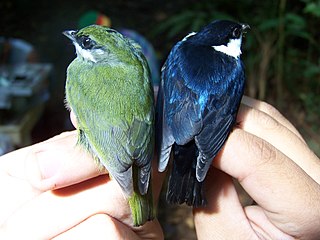 W
WCorapipo is a genus of birds in the manakin family Pipridae that are found in Central America and northern parts of South America.
 W
WHeterocercus is a genus of bird in the family Pipridae. Established by Philip Lutley Sclater in 1862, it contains the following species:
 W
WLepidothrix is a genus of passerine birds in the manakin family Pipridae. Birds in the genus are predominately found in South America, but one species, the blue-crowned manakin, also ranges into Central America. The females of this genus have green plumage with yellow bellies, as do some of the males. The remaining males have black plumage with white or blue crowns. Some also have yellow bellies or blue rumps.
 W
WMachaeropterus is a genus of passerine birds in the manakin family Pipridae. They are found in the tropical forests of South America.
 W
WThe band-tailed manakin is a species of bird in the family Pipridae. It is found in Argentina, Bolivia, Brazil, Paraguay, and Peru. Its natural habitats are subtropical or tropical moist lowland forest, subtropical or tropical swamps, and heavily degraded former forest. It forms a superspecies with both the Crimson-hooded manakin and the Wire-tailed Manakin.
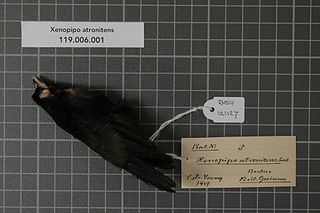 W
WThe black manakin is a species of bird in the family Pipridae. It is found in Bolivia, Brazil, Colombia, French Guiana, Guyana, Peru, Suriname, and Venezuela.
 W
WThe blue-rumped manakin is a species of bird in the family Pipridae. It is found in Colombia, Ecuador, and Peru. Its natural habitat is montane forest and, in Ecuador, the species is considered a foothill specialty. These tiny manakins, which average 8 cm (3.1 in) in length, are infrequently encountered away from their leks, where the black, white-capped and blue backed males display for female attentions.
 W
WThe cerulean-capped manakin is a species of bird in the family Pipridae. It is endemic to Peru.
 W
WThe crimson-hooded manakin is a species of bird in the family Pipridae. It is found in Brazil, French Guiana, Guyana, Suriname, and Venezuela. Its natural habitats are subtropical or tropical swampland and heavily degraded former forest. It is the northernmost member of the genus Pipra. It forms a superspecies with both the Band-tailed Manakin and the Wire-tailed Manakin.
 W
WThe fiery-capped manakin is a species of bird in the family Pipridae, the manakins. It is one of the five species in the genus Machaeropterus. It is named for its bright yellow head feathers.
 W
WThe flame-crested manakin is a species of bird in the family Pipridae. It is found in Bolivia, Brazil, and Peru. Its natural habitats are subtropical or tropical moist lowland forest and subtropical or tropical swampland.
 W
WThe golden-collared manakin is a species of bird in the family Pipridae.
 W
WThe golden-crowned manakin is a small species of perching bird in the manakin family (Pipridae). It is endemic to the south-central Amazon Rainforest in Brazil, and it is threatened by habitat loss.
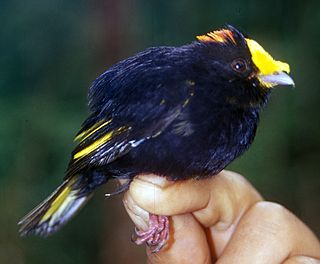 W
WThe golden-winged manakin is a species of bird in the family Pipridae. It is the only member of the monotypic genus, Masius.
 W
WThe green manakin is a species of bird in the family Pipridae. It occurs in humid forest in lowlands and foothills. The distribution is disjunct, with one population in the western Amazon Basin and adjacent east Andean foothills in southeastern Colombia, eastern Ecuador and eastern Peru, and another population in the humid Chocó in eastern Panama, western Colombia and northwestern Ecuador. It has been suggested that the latter population may be a separate species, the Lita manakin. As suggested by its common name both the male and the female of the green manakin are overall green. It remains fairly common locally, and is consequently considered to be of least concern by BirdLife International and IUCN.
 W
WThe jet manakin is a species of bird in the family Pipridae. It is found in Ecuador and Peru. Its natural habitat is subtropical or tropical moist montane forest.
 W
WThe kinglet manakin or eastern striped manakin is a small South American species of passerine bird in the manakin family Pipridae. It is found in the Atlantic Forest of south eastern Brazil. It was formerly considered conspecific with the striolated manakin with the common name "striped manakin". Males have a bright red crown, which the females lack.
 W
WThe olive manakin is a species of bird in the family Pipridae.
 W
WThe opal-crowned manakin is a species of bird in the family Pipridae. It is endemic to Brazil.
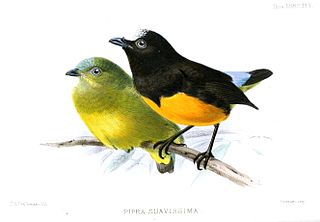 W
WThe orange-bellied manakin, also known as the tepui manakin, is a species of bird in the family Pipridae. It resembles and is closely related to the white-fronted manakin, and the two were formerly considered conspecific.
 W
WThe orange-crested manakin is a species of bird in the family Pipridae. It is found in Ecuador and Peru. Its natural habitats are subtropical or tropical swampland and subtropical or tropical dry shrubland.
 W
WThe painted manakin is a small South American species of passerine bird in the manakin family Pipridae. It was first described in 2017 from specimens collected in north west Peru.
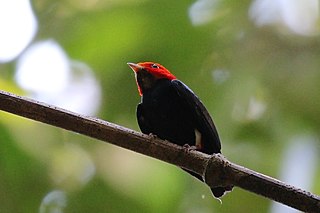 W
WThe red-headed manakin is a species of bird in the family Pipridae. It is found in Bolivia, Brazil, and Peru. Its natural habitat is subtropical or tropical moist lowland forest.
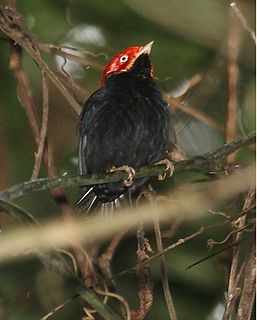 W
WThe round-tailed manakin is a species of bird in the family Pipridae. It is found in Bolivia, Brazil, and Peru. Its natural habitats are subtropical or tropical moist lowland forest and subtropical or tropical moist montane forest.
 W
WThe scarlet-horned manakin is a species of bird in the family Pipridae.
 W
WThe snow-capped manakin is a species of bird in the family Pipridae. It is found in the Amazon Basin of Brazil and far northeastern Bolivia. Its natural habitat is subtropical or tropical moist lowland forest. This is one of the parent species that hybridized to produce the golden-crowned manakin. A hybrid zone between this species and the opal-crowned manakin exists where the two species ranges come into geographic contact in the Cachimbo Range.
 W
WThe striolated manakin or western striped manakin is a small South American species of passerine bird in the family Pipridae. It is found in west and north west Amazonia. The striolated manakin was formerly considered conspecific with the kinglet manakin with the common name "striped manakin". Males have a bright red crown, which the females lack.
 W
WThe white-bibbed manakin is a species of bird in the family Pipridae. It is found in Colombia and Venezuela. Its natural habitats are subtropical or tropical moist lowland forest and subtropical or tropical moist montane forest.
 W
WThe white-throated manakin is a species of bird in the family Pipridae. It is found in Brazil, French Guiana, Guyana, Suriname, and Venezuela. Its natural habitat is subtropical or tropical moist lowland forest.
 W
WThe wire-tailed manakin is a species of bird in the family Pipridae. It forms a superspecies with both the Band-tailed Manakin and the Crimson-hooded Manakin . It is found upriver in the western Amazon Basin and the neighboring countries of northern Peru, eastern Ecuador and Colombia, and southern and western portions of Venezuela. In Venezuela it occurs upriver in the Orinoco River basin, but not the final 1300 km; its range in Venezuela continues around the Andes cordillera to the northwestern coast. In northwest Brazil, the species ranges from Roraima and Amazonas west to Venezuela and Colombia, and southwest from Rondônia and Acre to Peru and Ecuador.
 W
WThe yellow-crested manakin, also called the yellow-crowned manakin, is a species of bird in the family Pipridae, the manakins.
 W
WThe yellow-headed manakin is a species of bird in the family Pipridae.
 W
WThe Yungas manakin is a species of bird in the family Pipridae. It closely resembles the blue-backed manakin, but unlike that species it has dull dark red legs and is found in humid highland forests in the Yungas of southeastern Peru and Bolivia.
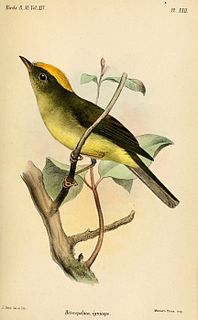 W
WNeopelma is a genus of bird in the family Pipridae.
 W
WPipra is a genus of birds in the manakin family Pipridae.
 W
WPiprites is a genus of bird traditionally placed in the family Tyrannidae.
 W
WThe black-capped piprites, also known as the black-capped manakin, is a species of suboscine passerine. It has traditionally been placed in the Tyrannidae.
 W
WThe grey-headed piprites is a species of bird which traditionally has been placed in the family Tyrannidae. It is found in Costa Rica, Guatemala, Honduras, and Nicaragua. Its natural habitat is subtropical or tropical moist lowland forest.
 W
WThe wing-barred piprites is a species of bird which traditionally has placed in the family Tyrannidae.
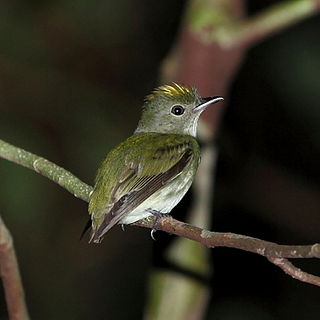 W
WTyranneutes is a genus of South American birds in the family Pipridae. Both genders somewhat resemble females of other manakins, but are even smaller. They are native to the humid forests in the Amazon and the Guianas. The two species are entirely allopatric.
 W
WThe dwarf tyrant-manakin or dwarf tyranneutes is a species of bird in the family Pipridae.
 W
WThe pale-bellied tyrant-manakin, or pale-bellied neopelma, is a species of bird in the family Pipridae.
 W
WThe saffron-crested tyrant-manakin, or saffron-crested neopelma, is a species of bird in the family Pipridae, the manakins.
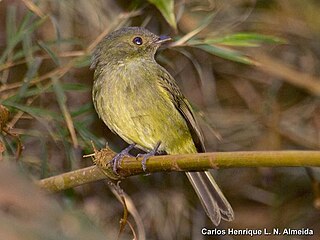 W
WThe Serra do Mar tyrant-manakin, or Serra do Mar neopelma or the Serra tyrant-manakin, is a species of bird in the Pipridae, or manakin family. It is endemic to humid mountain forest and woodland in south-eastern Brazil. It was formerly considered a subspecies of Wied's tyrant-manakin.
 W
WThe sulphur-bellied tyrant-manakin, or sulphur-bellied neopelma, is a species of bird in the family Pipridae. It is found in the western Amazon Basin of Bolivia, Brazil and Peru. Its natural habitat is subtropical or tropical moist lowland forest.
 W
WThe tiny tyrant-manakin or tiny tyranneutes is a species of bird in the family Pipridae. It is found in Brazil, French Guiana, Guyana, Suriname, and Venezuela. Its natural habitat is subtropical or tropical moist lowland forest.
 W
WWied's tyrant-manakin is a species of bird in the family Pipridae. It is endemic to Atlantic moist forests in eastern Brazil. It was previously considered conspecific with Neopelma chrysolophum. It is threatened by habitat loss.
 W
WXenopipo is a genus of bird in the family Pipridae.